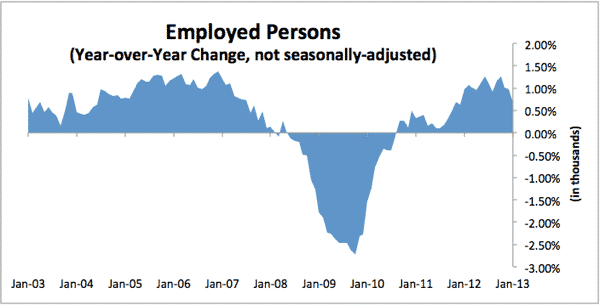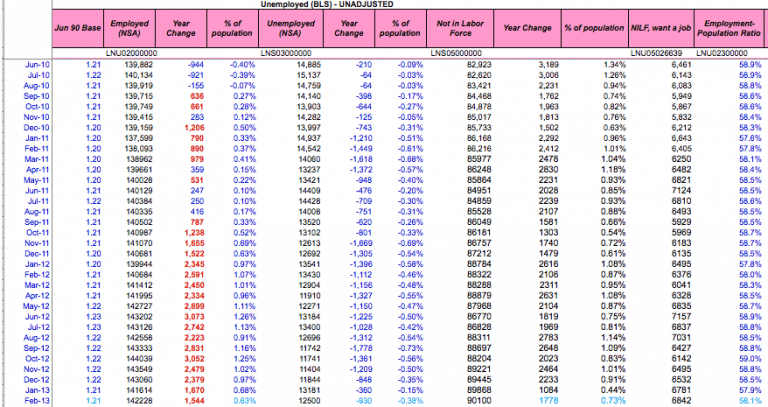Some thoughts on the February jobs data
The US employment situation summary for February showed an improving labor market with 236,000 jobs created and unemployment down to 7.7%. These numbers are indicative of an improving labor market and reflect the likelihood that the US will continue its economic expansion.
A lot of ink has been spilled on these numbers, so I don’t want to repeat what has already been said. Expect me to put a number of posts into the links on the numbers. Last month I showed you a chart which indicated that employment was increasing at a slowing pace, indicating that we were in the midst of a mid-cycle slowdown or a decline into a cyclical trough.

In past economic cycles, when we see the year-on-year change in the number of employed persons fall at such a rapid pace, it does not always mean recession. It has occurred mid-cycle as well. In 2003, this metric peaked at 2.0 million in November before declining to 908,000 in March 2004, for example. Another example is from 1997 and 1998, when the number declined from 3.2 million in April 1997 to 1.3 million in August 1998. We saw an even larger decline in 1994 to 1995 after the Federal Reserve raised interest rates The point here is that the employment numbers are indicative of a mid-cycle trough. What turns this trough into something greater are other confounding cyclical factors like interest rates or asset prices and so forth.
This month I thought I would show you how this data series looks in table form, along with a few other data points I track in this series. The chart is below.
The numbers are a bit small in this size, but you can click on the image to blow it up a bit. What it shows you is that the employment data are getting better more slowly than they were in 2012, with June 2012 being the local peak in the time series. I would be concerned about this if there were other factors that would add to this picture to inhibit economic growth. And to be sure, there are the sequestration and fiscal cliff cuts. But are these going to be enough, without a government shutdown to get us to recession? I don’t believe so. Lakshman Achuthan and ECRI have it wrong. The US is not in a recession now and the numbers are not pointing to an imminent recession either.
The NBER needs to see a significant decline in economic activity, lasting more than a few months in most all of the following metrics: real GDP, real income, employment, industrial production, and retail sales. None of those data series are declining. All of the recent economic data series out of the US are supportive of growth: consumer credit, Case Shiller house prices, new and existing housing transactions, Fed flow of funds, personal income and spending, retail sales, manufacturing and non-manufacturing PMIs, jobless claims, and the employment situation summary. While the government cuts are a threat to growth, it is not enough of a threat yet to overcome the wide array of upward looking economic statistics. This jobs data is very much in that vein.

Comments are closed.